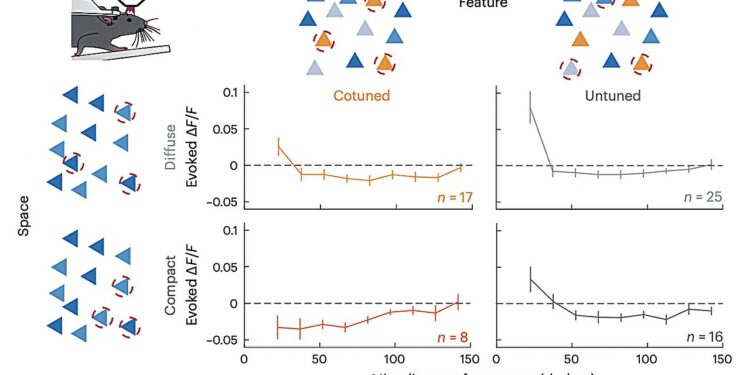The ensembles are divided into two categories as follows: in rows, whether they are diffuse (average distance >200 µm, top) or compact (0.7, left) or detuned (<0.3, right). Axis diagrams describe the design of the assembly in that row/column. Data shown are mean responses of nontarget cells ± sem as a function of their minimum distance from the array. Diffuse cotuned n = 17 sets, 9 FOV, 3 mice; untuned diffusion n = 25 sets, 13 FOV, 3 mice; compact cotuned n = 8 sets, 3 FOV, 1 mouse; compact untuned n = 16 sets, 7 FOV, 2 mice. Credit: Natural neuroscience (2024). DOI: 10.1038/s41593-023-01510-5.
In mammals, the perception of visual stimuli is supported by the coordinated activity of thousands of neurons in different regions of the brain. The images perceived by the eyes are represented in the brain through different stages through which the representations are increasingly refined.
A region of the brain that plays a key role in the processing and neural representation of visual stimuli is what is called the primary visual cortex or V1. Previous studies suggest that recurrent excitation of neurons in this brain region amplifies responses when visual cues are weak, while recurrent inhibition of neurons suppresses responses when signals are strong.
Although experimental results suggest that recurrent excitation and suppression play a key role in the detection and discrimination of objects or subjects in visual images, the cortical patterns underlying these processes are still poorly understood. A better understanding of these models could help to better understand the complex mechanisms underlying human vision.
Researchers from the University of California, Berkeley (UC Berkeley) and other institutes in the United States recently conducted a study on the recurrent activity of the primary visual cortex. Their findings, published in Natural neurosciencesuggest that cortical ensemble preferences impact local V1 recurrent activity following a simple logic.
“Recurring cortical activity sculpts visual perception by sharpening, amplifying, or suppressing visual input,” Ian Antón Oldenburg, William D. Hendricks, and colleagues wrote in their paper. “However, the rules that govern the influence of recurrent activity remain enigmatic. We used ensemble-specific two-photon optogenetics in the mouse visual cortex to isolate the impact of recurrent activity from the “external visual input.”
Oldenburg, Hendricks and their colleagues performed a series of experiments on adult mice. First, they used high-resolution two-photon (2P) holographic optogenetic techniques to recreate precise patterns of neuronal activity in the mouse brain. They then measured the impact of these models on the primary visual cortex, using 2P calcium imaging with cellular resolution.
“We found that the spatial layout and visual preferences of the stimulated ensemble and neighboring neurons jointly determine the net effect of recurrent activity,” the researchers wrote in their paper. “Photoactivation of these ensembles results in suppression in all cells beyond 30 µm, but uniformly results in activation in closer, similarly tuned cells. In no similarly tuned cell do compact and similarly tuned ensembles co-tuned sets result in sharp suppression, while diffuse, co-tuned sets result in activation.”
After conducting their experiments, the researchers used computational techniques to model their observations. This allowed them to better understand how the groups of neurons they stimulated influenced recurrent activity in V1.
“Computer modeling suggests that highly local recurrent excitatory connectivity and selective convergence on inhibitory neurons explain these effects,” the researchers explain in their paper. “Our results reveal a simple logic in which the space and preferences of cortical ensembles determine their impact on local recurrent activity.”
Recent work by Oldenburg, Hendricks, and colleagues brings together valuable new insights into the neural processes that could lead to amplification and suppression of activity in the mammalian primary visual cortex. Overall, the team’s findings suggest that recurring activity patterns observed in V1 are modulated via neural processes unfolding according to a specific logic, which ultimately allows the brain to derive a detailed representation of visual stimuli. complex.
In the future, these results could pave the way for new studies investigating the complex neural underpinnings of visual perception.
More information:
Ian Antón Oldenburg et al, The logic of recurrent circuits in the primary visual cortex, Natural neuroscience (2024). DOI: 10.1038/s41593-023-01510-5.
© 2024 Science X Network
Quote: The logic underlying recurrent activity in the primary visual cortex (January 25, 2024) retrieved January 25, 2024 from
This document is subject to copyright. Apart from fair use for private study or research purposes, no part may be reproduced without written permission. The content is provided for information only.



